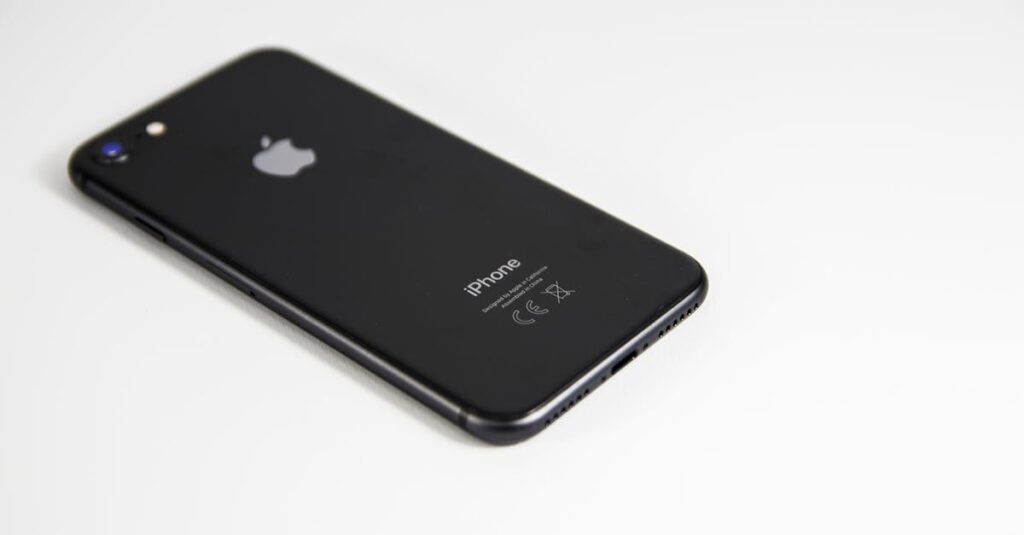Table of Contents
ToggleImagine this: your trusty phone, the one that’s seen you through countless selfies and late-night texts, suddenly decides it’s had enough. The screen’s cracked, the battery’s dead, and you’re left wondering how to rescue your precious data before it joins the great tech graveyard. Fear not! Transferring data from a broken phone to a shiny new iPhone isn’t as daunting as it sounds.
Understanding Data Transfer Challenges
Transferring data from a broken phone presents several challenges. Physical damage might limit access to important information such as contacts, photos, and messages. Corrupted software can prevent the device from functioning properly, complicating the transfer process. Users face issues when screens become unresponsive or when devices fail to power on.
Determining the extent of the damage is crucial. If the screen is cracked but the phone still powers on, methods like cloud backup or using specialized software can facilitate recovery. Prioritizing data types matters; photos and contacts often hold the most value. Ensuring data integrity during transfer is essential to prevent loss.
Utilizing tools like iTunes or iCloud simplifies data management but requires a functioning device. Backup solutions, like Google Drive or Dropbox, offer alternatives for accessing data on a broken phone. In cases where data retrieval isn’t straightforward, consulting a professional service might be necessary.
The age of the device influences recovery options. Newer models have advanced technologies that enhance data recovery. For example, iPhones with Face ID may allow access through facial recognition, even with a cracked screen. Understanding these nuances helps users navigate potential obstacles effectively.
Preparation becomes key in successful data transfer. Robust plans ensure minimal disruption when switching devices. Gathering necessary cables and tools ahead of time streamlines the process, reducing frustration. Addressing each challenge with a clear strategy ultimately leads to securing valuable data.
Assessing the Condition of Your Broken Phone
Assessing the condition of a broken phone is essential for effective data recovery. An understanding of the specific damage types and the device’s current functionality guides the recovery process.
Identifying Types of Damage
Physical damage like cracked screens, water exposure, or battery issues can affect data access. Cracks on the screen may render touch features unusable, while water damage could lead to internal corrosion. Corrupted software can also signal trouble, limiting options to retrieve information. Depending on the severity, some issues may allow partial access to data, while others might completely block it. Assessing these damage types helps users prioritize their recovery methods.
Determining Functionality
Functional checks reveal a lot about data recovery feasibility. If the phone successfully powers on, options increase for accessing data. Listening for sounds or vibrations may indicate responsiveness, suggesting levels of functionality. A responsive touch screen enables easier navigation, while a non-functional one presents retrieval challenges. If apps and features react, this indicates that recovery tools might extract data. Clarifying these functionalities assists in selecting the right tools and methods for transferring data.
Preparing for Data Transfer
Preparing for data transfer involves gathering essential tools and software while ensuring backups for data where possible.
Essential Tools and Software
Users need specific tools to facilitate the transfer process. iTunes serves as a primary tool for both backups and data recovery, enabling seamless transfers to the new iPhone. iCloud offers another option by wirelessly syncing data, provided the damaged phone was previously backed up. Third-party software like Dr.Fone can assist in recovering data, even from broken devices. Understanding which tool aligns with their situation enhances recovery chances. Users must prioritize selecting tools based on the type of damage. For example, a phone with a functional touchscreen allows for direct data transfer methods, increasing the number of options available.
Backing Up Data Where Possible
Backing up data significantly enhances recovery possibilities. Users should access the phone’s settings to check for existing backups in iCloud or iTunes. If the device powers on, creating a new backup is crucial. Data types like contacts, messages, and photos often hold the highest priority, so securing these first is wise. If users cannot access the phone, previous backups may offer a vital safety net. Checking cloud services like Google Drive or Dropbox adds further layers of security. By focusing on the most critical data, users can better navigate the backup process.
Methods for Data Transfer
Transferring data from a broken phone to a new iPhone involves several effective methods. Each option accommodates different damage scenarios and user needs.
Using iCloud for Data Recovery
iCloud offers a seamless method for data recovery. Users can restore information from previous backups if the damaged phone still powers on. Accessing iCloud requires a reliable Wi-Fi connection and the Apple ID associated with the account. Log in to iCloud on the new iPhone and select the desired data types like contacts, photos, and messages. If the broken phone’s data is backed up, this process typically retrieves a majority of key information easily. Checking iCloud settings on the damaged device beforehand increases the chances of successful recovery.
Utilizing Third-Party Software
Third-party software serves as an excellent resource for recovering data from broken devices. Programs such as Dr.Fone or EaseUS MobiSaver target various data types, providing user-friendly interfaces for easy navigation. Compatibility varies; many of these tools support both iPhone and Android devices. Connect the broken phone to a computer and run the software to scan for retrievable data. Following the prompts facilitates the extraction process. Each software option might offer different features, so users should evaluate which program aligns best with their specific situation.
Physical Connections: USB and Adapters
Using physical connections like USB cables and adapters is another productive approach. If the broken phone remains operational, connecting it to a computer enables direct data transfer. Ensure that the correct USB cable suitable for the damaged device is available. When linked, the new iPhone can access the old device’s files, allowing manual data transfer through various applications. This method is particularly effective for transferring images and documents. Utilizing file management software can simplify the process further, ensuring that users keep track of essential data during transitions.
Finalizing the Transfer
Finalizing the data transfer process is crucial for ensuring all important information is correctly migrated to the new iPhone. Users must take specific steps to confirm that the data is intact and accessible.
Verifying Data Integrity
After the transfer, it’s essential to check that all files, contacts, and messages transferred correctly. Users should look through their contacts list to confirm each entry is present. Additionally, checking photo albums for missing images or videos can reveal transfer issues. A simple way to verify text messages is to open conversations and scroll through them. Ensuring that apps reinstall properly increases confidence in the data integrity. Coordinating with cloud services helps in validating that backups were successful. Reliable tools will facilitate this process, making it easier to identify discrepancies.
Setting Up Your New iPhone
Once data verification is complete, setting up the new iPhone is the next step. Activating the device involves following simple on-screen instructions. Users must connect to Wi-Fi for optimal performance and additional software updates. Customizing settings according to preferences enables a more personalized experience. Furthermore, signing into iCloud should be prioritized to sync contacts, calendars, and photos seamlessly. Configuring security settings, such as Face ID or passcodes, helps protect personal data. Users should also download essential apps to enhance functionality. Establishing notifications and alerts lets users stay organized and connected.
Transferring data from a broken phone to a new iPhone can feel daunting but it’s entirely achievable with the right approach. By assessing the damage and selecting appropriate recovery methods users can secure their valuable information. Whether utilizing iCloud backups third-party software or direct connections each option provides a pathway to recovery.
Preparation is key to a smooth transition. Ensuring backups are in place and understanding the tools available makes the process more manageable. Once the data is successfully transferred users can enjoy their new iPhone while knowing their cherished memories and important contacts are safe. With a little patience and the right strategies anyone can navigate this challenge effectively.




